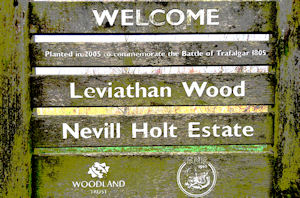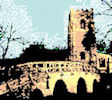Leviathon Wood
 How did Medbourne's Leviathon Wood come into being with this particular name? Read on...
How did Medbourne's Leviathon Wood come into being with this particular name? Read on...
History
The Napoleonic Wars between 1799 to 1815 consisted of a number of battles between France and various European nations. In October 1805 the Franco-Spanish fleet set sail for Italy from Cadiz in south west Spain but off Cape Trafalgar they were ambushed by the British fleet commanded by Vice Admiral Horatio Nelson. Although heavily outnumbered in men and ships, due to Nelson’s ambitious tactics the British won a decisive victory, although Nelson himself was killed. Never again was Napoleon in a position to threaten to invade the British Isles.
The Woodland Trust
The year 2005 marked the 200th anniversary of the Battle of Trafalgar and the Woodland Trust saw an opportunity to celebrate the “unsung heroes” of the battle, the trees which were used to build the fleet. As a result of extensive fund raising and with assistance from the Society for Nautical Research the Trust embarked on an ambitious project to arrange for the planting of twenty seven “Trafalgar Woods” one for each ship of the line at Trafalgar.
HMS Leviathon
Construction of HMS Leviathon started in May 1782 at Chatham Dockyard and she was launched in October 1790. She originally had 74 guns and a crew of 640, at Trafalgar her Captain was Henry William Baynton. Following the end of the Napoleonic wars in 1816 she became a prison ship (hulk) at Portsmouth but was finally broken up in 1848. See picture below of the ship in action.

The Wood
The wood is located adjacent to the Field Road to Blaston which is off the Uppingham Road on the outskirts of the village. The land on which the wood is situated is owned by David Ross who kindly made it available in exchange for a lease on the Avenue at Nevill Holt which is owned by the Woodland Trust.
The Trust arranged for the initial planting in 2003/2004. Later in 2012 Bryan Smith, the village Tree Warden, became aware that Groundwork Leicester and Leicestershire were making trees, stakes and protective spirals available and appoximately 800 trees were planted in March 2013, consisting of Alder, Oak, Beech, Silver Birch, Hazel, Hawthorn and Cherry.
Subsequently, on application the Woodland Trust started to donate packs of up to 400 trees consisting of those mentioned above, in addition to Rowan, Ash, Blackthorn, Field Maple and White Willow. Over a period of three years applications were made in Autumn and Spring and the planting was carried out by dedicated bands of volunteers, often in inclement weather and ground conditions! See the Picture Gallery for photos of the tree planting volunteers over the years. In total approximately 5,500 trees have been planted.
Apart from the trees themselves the wood has proved a haven for wild life, attracting numerous species of mammals and birds together with many varieties of wild flowers.
Conclusion
The wood is not only a fitting tribute to the men and ships who fought at Trafalgar but is also a lasting legacy for future generations in the village to enjoy.
Acknowledgements
Contributed by Keith Sandars with considerable help from Bryan and Laurie Smith and The Woodland Trust. March 2017.

